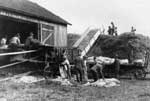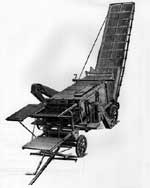| Harvest time on the farm meant socializing, hard work, and anticipation. The amount of workers needed meant that neighbors often cooperated together to thresh small grains such as oat or wheat. When the threshing was done, the farm family knew what kind of yield their labor produced, and whether it would be a lean or prosperous year.
From the late 1800s into the 1930s, many American farm families worked together to thresh grain using a steam engine and a threshing machine. Threshing is the process of knocking the grain off the straw, and by the late 1880s implied separating the grain from the chaff. As the quote from Margaret Dow Gebby illustrates, a day of threshing grain meant the women on the farm had to prepare a meal for more than a dozen men, and in her case two meals. In the field, it required a crew to load the wagons with grain, feed bundles into the threshing machine, stack the straw, and haul away the clean grain. An engineer monitored the steam engine that powered the thresher. All able hands contributed during threshing as crews traveled from farm to farm, setting up the thresher and steam engine.
At Greenfield Village we demonstrate the excitement and cooperation of farm work during our Fall Harvest Days. On October 1st, 7th and 8th, 2000 we will thresh our Turkey Red Wheat with our newly restored Westinghouse threshing machine, built about 1905, and powered by a Port Huron steam traction engine. Henry Ford likely bought the threshing machine in the 1910s or 1920s. The serial number is currently painted as 4406, but research shows that it is a later model with a serial number of 7357. Henry may have done this to represent a machine he remembered from his boyhood.
|
|

Threshing on Ford Farms with Westinghouse threshing machine, ca. 1925. |
By 1903, the Westinghouse Company offered seven different models of threshing machines, ours is the second largest, the 00 Model. It requires 12 horsepower to operate efficiently with the threshing cylinder turning about 1,000 revolutions per minute. This machine was capable of threshing about 700 bushels of wheat a day. That is about 42,000 pounds of grain.
Though combined reaper-threshers, today we call them combines, were invented by 1834, the machines did not replace threshing machines until tractor-drawn machines were developed in the 1920s. World War II contributed to the end of threshing machines, as farmers converted to tractor farming, and the scarcity of farm workers promoted the labor-saving combine, and the end of the threshing crew.
Read more about our Port Huron steam traction engine on our site at
http://www.TheHenryFord.org/histories/pic/97.oct.html
See images of threshing on the Great Plains on the Library of Congress web site
http://lcweb2.loc.gov/cgi-bin/query/r?ammem/ngp:
@FILREQ(@field(SUBJ+@BAND(threshing+crews))
+@FIELD(COLLID+ndfa))
|
|

Catalog image, ca. 1885. |

